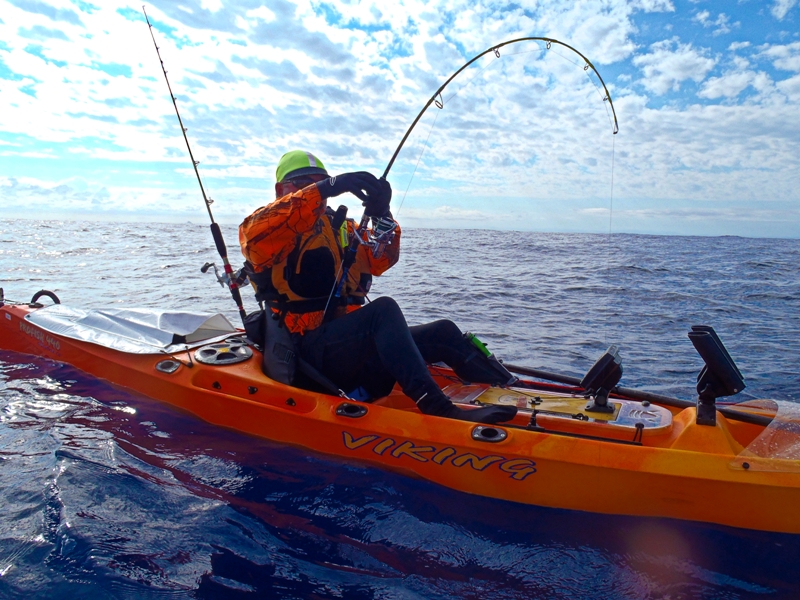Deep Water Kayak Fishing
2:17AM 13th Dec 14

It’s not always about the glamour species, the humble gemfish on lighter line is fun and makes great table fare
Into the deep
My calendar at this time of the year normally has as many weekends as possible blocked out in anticipation of the snapper run. Light tackle is tuned and grab bags made ready to make the most of any weather window to hit Bream Bay, the Bay of Islands, or Doubtless Bay. The lure of having large fit snapper dragging rod tips deep into the water beside the kayak usually has me thinking of little else (much to the disgust of some of those I work with!).
This year it’s a little different though. With the exception of a trip wide of Cuvier Island and a few drops at moderate depths it’s been a long time since I’ve kayak fished waters where baits and lures need more than a couple of minutes to reach the required depth. For a change of pace this spring we’re going to focus on the challenges of fishing deeper waters.
To start we’ve booked a mothership trip with Rick Pollock aboard Pursuit. If the weather will allow the plan is to get the kayaks out to White Island for a look at the spring run of big kingfish, and then a drop one of the many knolls for bluenose, hapuku, or any other deep water ooglie. It may even be possible to add to the species list caught from kayaks in New Zealand waters.

Lighter line on fixed spool reels is an option for some, especially if you struggle with laying the line. Using lighter 24kg braid ensures enough capacity.
Another attraction of this trip will be the opportunity to put a secret weapon through its paces, a new kayak that’s been designed with mothership trips in mind. The culmination of more than 12 months of work it will be great to see it in action doing battle on heavy gear (test paddles have already proven it’s more than capable).
As mentioned back in September we’re also looking at paddle-from-shore deep water missions. The plan is to head out from Lottin Point or Hicks Bay to try for blue nose on the drop off. Last time I fished wide of Lottin Point (reported in the August 2009 issue of the Fishing News) I only dropped one bait, and was promptly taken on a Nantucket sleigh ride over the drop before finally being spooled. This is unfinished business and I have a few new tricks to try!

Unfinished business: this is what being spooled at the drop off wide of Lottin Point looks like, this time I’m going back with more line
Tackling up
Since my last true deep water missions I’ve had opportunities to put a few theories to test, and as a result I’m changing my approach in a few areas. In a nut shell it’s all about the fact that we’re fishing from kayaks rather than bigger craft, and that gives us a few advantages and disadvantages compared to fishing from larger boats.
By far the biggest difference is that we’re much easier to tow around. Talk to any kayak angler and you’ll get stories of how even modest fish drag us about – that’s part of what makes this sport so exciting. When fishing shallow water this is of huge benefit as it allows us to quickly get over top of a fish, reducing line angles and minimizing the risk of a reefing.
In deep water the ability to wind the kayak on top of a fish and keep it there is less about staying out of structure and more about keeping in contact with your catch. This becomes very important with fish like hapuku that can float off hooks if care isn’t taken. It also means that unlike bigger boats on breezy days that can drift a long way by the time the catch surfaces, kayaks make it considerably easier by staying close over top of the fish.
A huge advantage is that this allows us to drop to slightly lighter gear, especially considering we aren’t fighting the drift of a larger vessel as well at the fish we have on the end of our line. As a result, while I still have a 37kg braid outfit for extreme fishing, most of my deep water rigs are now a mixture of 24kg and 15kg line classes. After more than two years fishing these lighter classes out to 150m I have yet to suffer a bust off.
Yes, I’ve occasionally been reefed, but in those situations it wouldn’t have mattered if I was fishing 37kg, or even 60kg, the fish would still have had me amongst the stones with little chance of keeping it attached.
So what’s the benefit of fishing lighter lines in deep water? I find that it’s often much faster getting baits and lures to the depth required. This makes it easier to stay on the mark or calculate how far you need to be up current to ensure your terminal gear ends up on the spot. It also makes it much less work winding up to re-bait or reset for another drift (this is especially important if on a paddle-from-shore mission and you need to leave enough energy for the paddle home).
Using lighter lines also makes it possible to fish deep water with smaller reels. The increase in braid capacity dropping from 37kg to 24kg is very significant and makes it possible for anglers to use reels they may already have on hand. This helps make trips more affordable as there’s no need to purchase specialized sets that will only be used occasionally.

When fishing beyond 150 meters most of my rigs are single hook, especially if targeting hapuku or bass. I consider two hook maximum as a double strike can be almost impossible to get to the surface.
Rigs and Breakaways
One disadvantage with fishing from kayaks is our limited lifting power. While our mobility on the water can work to our advantage with minimizing getting fouled, sometimes there’s no substitute for sheer brute force. When bottom bouncing beyond 200 meters there’s a temptation to put down multiple hooks (if one bait gets stolen there are still others working for you), but in this situation there’s also the serious risk of a multiple hookup.
The classic example is some of the commercial 3 – 5 hook bluenose rigs available. A single 8-15kg fish from 200 meters is easily manageable (though work enough); a double hookup is going to have you build up a sweat by the time your catch hits the surface. Having more than two serious fish on at the same time could well see you unable to budge them, especially if they happen to be hapuku or bass! For this reason I like to keep my rigs to a two hook maximum when targeting bluenose and gemfish, and single hooks when targeting bigger species.
Another absolutely essential addition to my rigs is a breakaway for the sinker. It need be nothing more than a heavy rubber band or a loop of 6-8kg mono. I have to admit to a very embarrassing battle, spending a good 15 minutes “fighting” a reef in really deep water. There was enough oceanic swell to take line off me which I’d then battle back on the reel, only to lose it again to another “run” a couple of minutes later.
It took me the 15 minute battle to work out it was simply the same piece of line going backwards and forwards in time with the swells! Locking up for several minutes detected nothing more than the kayak moving on top of the ocean, and when the sinker finally popped free I wound both my baits back to the surface. I was one very puffed angler staring at a badly scratched sinker while kicking himself for all that wasted energy.

Breakaways for sinkers should be considered essential, sometimes they’re the only way to discover if you’ve just fouled the bottom or you really do have a massive bass on your hook!
Eggbeaters and free-spools
This has become a perennial question with the advent of strong reliable fixed spool reels with the drag performance and line capacity for the job. I confess to preferring free spool reels on kayaks for two main reasons:
- since the line feeds off the spool without the loose loops of a fixed-spool you have much better sensitivity for detecting bites on the way down
- since free spool reels sit on top of the rod it’s much easier to use the top of your thigh as a rod rest during battle. This takes pressure off arms and back, and helps conserve energy for paddling
The big appeal of fixed spool reels is that they’re virtually impossible to overrun (birds-nest), and there’s no need to lay the line evenly on the spool. When fighting long battles lifting fish from the depths not having to lay line is a huge advantage, allowing a grip further up the rod for more leverage and letting you use a straight arm to take the strain off tired muscles.
The negative is with having a fixed spool reel hanging below the rod is that care must be taken in the close confines of a kayak to ensure the spinning bail doesn’t contact anything.








